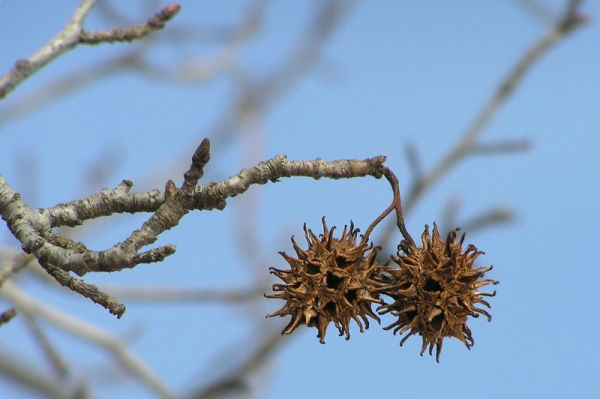
I couldn’t resist this title even though these are actually sweetgum balls.
Sweetgum trees are a southern species whose natural northern limit barely extends into Pennsylvania. However, they’re a favorite street tree so you’ll find them further north.
Sweetgums (Liquidambar styraciflua) have star-shaped leaves with 5-7 lobes. They’re easy to identify in winter because their woody seed balls dangle from the branches. American goldfinches dangle from the gumballs to extract the seeds.
The gumballs look spiny but after a harsh winter they don’t hurt — or at least they don’t hurt me. See below(*)
In early spring the seed balls fall off the tree and litter the ground below. If you’re not looking up, that’s how you’ll discover you’re near a sweetgum tree.
My strangest encounter with “gumballs” was while participating in the Mt. Davis Christmas Bird Count in Somerset County, Pennsylvania about 15 years ago. At one of our stops during the count we got out of the car at a bottomland near an old farmstead. Parked in what used to be the side yard was an abandoned Volvo station wagon and inside the back of that car were thousands and thousands of sweetgum balls. It was filled to the windowsills.
Someone went to a lot of trouble to collect those “gumballs,” then left them in an old car. I wonder why.
(photo by Dianne Machesney)
(*) Sweetgum balls can hurt bare feet, but not always. See the comments below for remarks on hurting. See this American Orchard blog post for an experiment in Ohio showing they don’t hurt except with bare feet on pavement. I rarely walk with bare feet so I’m immune

‘Trees of Pennsylvania,” Rhoads & Block and “The Vascular Flora of Pennsylvania,” Rhoads & Klein show the natural range of Sweetgum being along the SE coastal portion of PA where it grows in low lying areas in the vicinity of wet areas. It is planted extensively as an ornamental species in cities, etc. I think when I have checked for seeds in the gumballs outside of its natural occurrence, either the seeds are not developed, or critters have harvested the good ones. But if critters are collecting the seed balls, it seems that there would be fertile seeds. I haven’t noticed seedlings of Sweetgum which would also be indicative that there is fertile seeds being produced.
Interesting. I used the Sibley Guide to Trees to find the range of the sweetgum tree, but Sibley’s Guide didn’t differentiate the range between natural & ornamental occurrence.
Maybe Sibley used the USDA Plants Profile site at this link. http://plants.usda.gov/java/county?state_name=Pennsylvania&statefips=42&symbol=LIQUI.
I can’t believe that you wrote “The balls look spiny but they don’t hurt.” Obviously you have never stepped on a sweetgum ball in bare feet or had one shoot out of the back of your lawnmower to whack you in the shins!
Here in NC we have many sweetgums, and they are regularly cursed for their ever present balls, and virtually indestructible wood.
Emily, Ah ha! Your comment explains everything! I didn’t know that where sweetgums occur naturally (NC) the gumballs do hurt.
Here, the sweetgums aren’t fertile (per Mark’s comment) and the winter weather breaks down the spines. I know this because I actually picked up a gumball to test it in my bare fingers before I wrote that sentence. The tips were a bit soggy & broken from freezing repeatedly.
Maybe the only cultivated sweetgum tree that will grow under these winter conditions is one with wimpy gumballs.
I imagine small rodents like chipmunks or mice stockpiled those gumballs in the car. When we had a farm, small rodents were always hiding dog food pellets in various places in our car, including on the engine.
In our family we had several small antique side chairs and some bentwood chairs that were supposed to have been built from sweet gum wood.